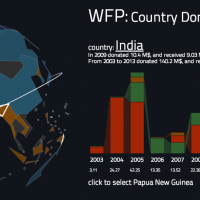In early July I read in The New York Times that the World Bank is releasing 7,000 data sets into the public domain.
So I decided to check it out and see what’s there.
Not a lot, it turns out. When it comes to agricultural information – arguably the most important sector of the Bank’s development work – even it has admitted publicly how lacking their data really is.
“In some sectors, however, data quality lags severely behind,” writes World Bank blogger Raka Banerjee in her article Open Data is Not Enough. “For example, despite the importance of the agricultural sector in reducing poverty and food insecurity throughout the developing world, serious weaknesses in agricultural statistics persist.”
It is easy to see the problems Banerjee is referring to. Just take a look at much of the Bank’s “Agriculture and Rural Development Data.” Tables like “Agricultural Methane Emissions” (a chart revealing each country’s methane emissions from cows and pigs and rice) are “data sets” with no data. Why bother?
Conversely, other data is overwhelming. I waded through the Fertilizer Consumption table (which looks at chemical fertilizer use, not compost and manure) and put some of the regional and developmental data sets into Many Eyes. The outcome was perhaps even more confusing: a bar graph cluttered with information.
But there are a few things this data can tell us. First off, while chemical fertilizer use in North America and Europe (and in “high income” countries in general) is still the highest in the world, it is decreasing. One clear reason is that as crude oil costs increase, petroleum-based fertilizer becomes more expensive. Potash (potassium) – one of three main fertilizer nutrients – is also in short supply, even as earnings of fertilizer companies go through the roof.
Yet perhaps the decrease is also because organics and sustainable agriculture is making a dent in chemical use – a trend we could continue as chemical costs continue to rise.
(Interestingly, New Zealand’s fertilizer use is off the charts, and for those enamored with Europe, according to this data, their use of chemical is higher than it is in the U.S.)
It also is clear those living in the most heavily indebted, low income and least developed nations are not using much fertilizer at all. This reflects the fact that most small farms can’t afford to buy expensive inputs and farmers have little or no access to such chemicals.
To some, this graph makes the case for increasing access to chemical fertilizer in low income places – a mandate to open as many shops in rural Peru as possible, and to offer government subsides in Malawi so more farmers can afford fertilizer (to grow more crops, to buy more fertilizer…).
But my interpretation of this data is that there is an opportunity for organic and sustainable agriculture to thrive in places with huge debt and little infrastructure. Instead of lending money to poor farmers to purchase fertilizer, why not emphasize better farm management and free composting systems? Like using urine to grow more tomatoes, for example. The more produce and grain farmers can grow without increasing their costs and putting more chemicals on the land, the better for all of us. Especially the farmers.





